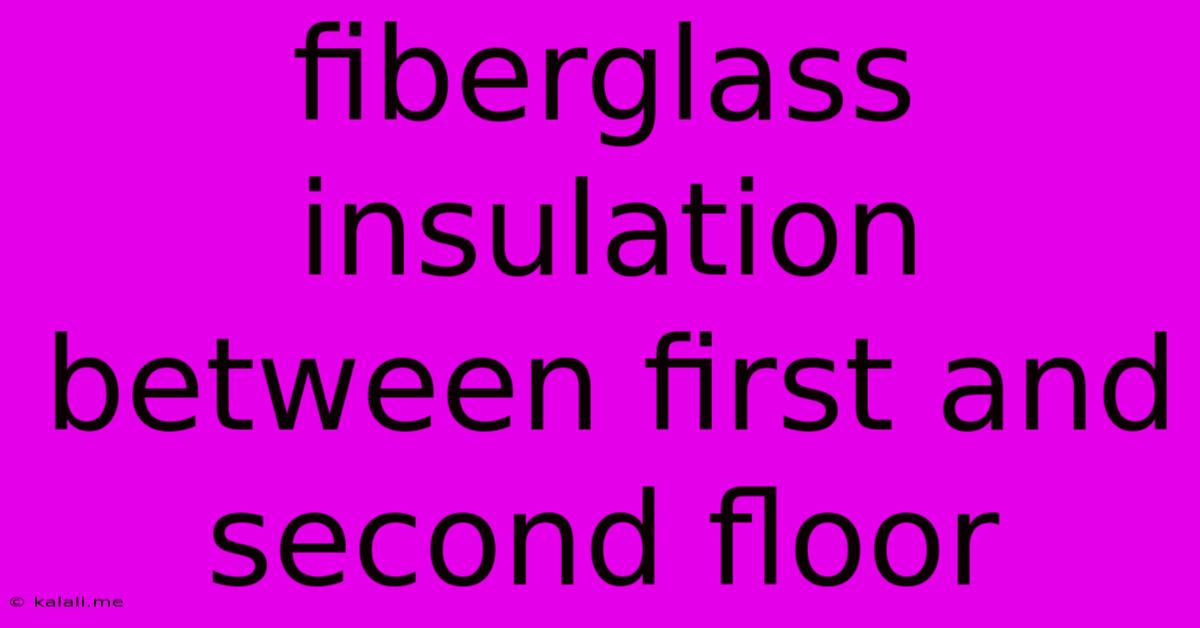Fiberglass Insulation Between First And Second Floor
Kalali
Jun 06, 2025 · 3 min read

Table of Contents
Fiberglass Insulation Between First and Second Floor: A Comprehensive Guide
Meta Description: Learn everything about installing fiberglass insulation between your first and second floor for superior home insulation, including R-value considerations, installation techniques, and potential challenges. Boost your home's energy efficiency and comfort!
Improving your home's energy efficiency is a smart investment, and one of the most effective ways to do this is by properly insulating your floors. Fiberglass insulation is a popular and readily available option for insulating the space between your first and second floor, offering excellent thermal resistance and sound dampening properties. This comprehensive guide will cover everything you need to know about using fiberglass insulation for this purpose.
Understanding R-Value and Choosing the Right Insulation
Before you begin, understanding R-value is crucial. R-value represents the thermal resistance of the insulation; a higher R-value means better insulation. The appropriate R-value for your climate will vary; check your local building codes or consult an energy auditor for recommendations. Generally, higher R-values are better for colder climates. You should also consider the depth of your joist spaces when selecting insulation. Thicker insulation batts will typically have higher R-values.
Types of Fiberglass Insulation for Floor Applications
Several types of fiberglass insulation are suitable for between-floor installations:
- Batts: These are the most common type, coming in pre-cut sizes to fit standard joist spacing. They’re easy to install and relatively inexpensive.
- Rolls: Similar to batts, but come in rolls and need to be cut to fit. This can be advantageous if you have unusual joist spacing.
- Loose-fill: This type is blown into the joist cavities using specialized equipment. It's ideal for uneven spaces and can fill gaps more effectively. However, it requires professional installation.
Preparing for Installation: Safety First!
Proper preparation is key to a successful insulation project. Always prioritize safety:
- Wear appropriate personal protective equipment (PPE): This includes gloves, a long-sleeved shirt, long pants, safety glasses, and a dust mask. Fiberglass can irritate skin and lungs.
- Inspect the area: Check for any existing wiring, plumbing, or other obstacles that may interfere with the insulation installation.
- Clear the area: Remove any debris or obstructions from the area where you’ll be working.
Step-by-Step Fiberglass Insulation Installation Guide (Batts & Rolls)
- Measure and Cut: Measure the joist spacing and cut the batts or rolls to fit snugly. Slightly oversized batts are better than undersized ones to prevent gaps.
- Install the Insulation: Carefully insert the insulation batts or rolls between the joists, ensuring a tight fit. Avoid compressing the insulation, as this reduces its R-value.
- Fill Gaps: Use scraps of insulation or caulk to fill any gaps or crevices.
- Inspect Your Work: Check for any remaining gaps or areas where insulation isn't properly seated.
Addressing Common Challenges
- Uneven Joist Spacing: If your joist spacing is irregular, loose-fill insulation might be a better choice. You can also use smaller pieces of batt insulation to fill gaps.
- Existing Wiring and Pipes: Carefully work around any existing utilities. Never compromise safety.
- Difficult Access: If access is limited, consider using a blower door to help distribute loose fill insulation.
Finishing Touches and Post-Installation Considerations
Once the insulation is installed, consider adding a vapor barrier to prevent moisture from entering the insulation. This will further improve its effectiveness and longevity.
Remember to properly dispose of any leftover insulation materials.
By following these steps and addressing potential challenges, you can effectively insulate the space between your first and second floor using fiberglass insulation, significantly improving your home's energy efficiency, comfort, and soundproofing. Investing time in proper insulation is a worthwhile endeavor that yields long-term benefits.
Latest Posts
Latest Posts
-
Can You Take Shaving Cream On A Plane
Jun 06, 2025
-
Janitor Ai Prompt Copy And Paste
Jun 06, 2025
-
Bolt Is A Bit Of Hardware Connections
Jun 06, 2025
-
What Does Get Out Of Dodge Mean
Jun 06, 2025
-
How To Format Sd On Mac
Jun 06, 2025
Related Post
Thank you for visiting our website which covers about Fiberglass Insulation Between First And Second Floor . We hope the information provided has been useful to you. Feel free to contact us if you have any questions or need further assistance. See you next time and don't miss to bookmark.